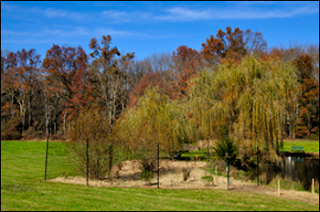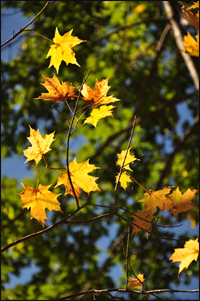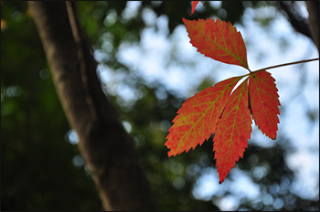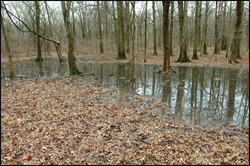by Ann Campbell, Jim Northrop, & Steve Reynolds


Fall colors on display at Bayne Park in Harding Township, NJ.
Like most other plants, trees rely on a biological process called photosynthesis to manufacture the nutrients they need to survive. Photosynthesis works by using light from the sun to convert carbon dioxide and water into the food compounds — sugars and other carbohydrates — necessary for growth and renewal. Since most of a tree’s photosynthesis takes place in the leaves, it is little wonder that those beautiful, ornately-veined structures have evolved to expose as much surface area as possible to incoming sunlight.
But what is it within each leaf that interacts with sunlight? And what is it we see in autumn when leaves turn from green to red or gold, purple or orange? The answer is pigment.
Trees leaves contain several pigments. All of them are important to the function of photosynthesis, but each one plays a slightly different role. Most of us already know about chlorophyll. It’s the green stuff found in plant cell bodies known as chloroplasts. Chlorophyll does all the heavy lifting of photosynthesis, and it’s the reason why leaves appear green to us for much of the year.


Red, purple, and blue pigments known as anthrocyanins also feature in the composition of leaf tissue, although they accumulate outside of the chloroplasts in the sap. These compounds excel at absorbing high-energy light waves, especially those found in the blue-green and ultraviolet portions of the spectrum. This means that anthrocyanins are even better than the carotenoids at being “leaf sunscreen.” It also means that they are found in greatest quantity when days are sunny and long.
All three pigments—chlorophyll, carotenoids, and anthrocyanins—are present inside of a leaf at any given time. Most trees would be hard pressed to survive, let alone mature and grow, if they entirely lacked any one of them. Still, this seems contrary to the human experience of autumn when the passing of one season into another is marked by a change in foliage color.
The truth is that autumn’s fireworks display—as well as the other, subtler color shifts one sees in leaves—has everything to do with how much of each pigments is present at any one moment. For instance, in early spring when new leaves are unfurling, concentrations of chlorophyll are still ramping up, while the carotenoids are already hard at work hard protecting tender new tissue from the sun. The result is a leaf that is lighter green, even yellowish, in hue.
As spring gives way summer, lush greens prevail in the forest. This is when trees are working overtime to produce and replace chlorophyll at an almost-alarming rate. They are so committed to overproducing the green stuff that all of the other colors gifted by carotenoids and anthrocyanins completely disappear. This is an important point to note. Those deep emerald hues of high summer not only reflect a tree’s need to synthesize food for growth and maturation, they also indicate a steady build-up and conservation of energy aimed at shepherding the rest of the tree through the harsh temperatures and low-light conditions of the impending winter. After all, there will be no leaves to create food in just a few short months.
As autumn dances in, it is the duration of daylight—rather than falling temperatures—that prompts a tree to change its outfit. Even so, rainfall and thermal variations affect the variety of colors it will choose to show. Because carotenoids are always present, you can count on yellows, golds, and browns in fall forest foliage just about every year. But those gorgeous red and purple anthrocyanins will only erupt when sugar levels in leaf sap are quite high. For that to happen, most of the growing season will need to have supplied lots of sunny days and plenty of moisture.
A lot of environmental variables and a lot of chemistry go into producing the annual parade of color everyone has come to expect from our forests. That said, all bets are off if Mother Nature pitches a curve ball like an early frost or a few strong autumn storms. Heavy rains or unseasonable snow will knock senescent leaves from their branches. Freezing temperatures will stop the production of vibrant anthrocyanins dead in its tracks. Droughts too can stress trees, which, in turn, may prompt the shedding of leaves before any color develops at all.
What is the lesson then? Autumn passes quickly and it may not be so glorious next year. Enjoy the fall you have right now, and enjoy it while you can!

